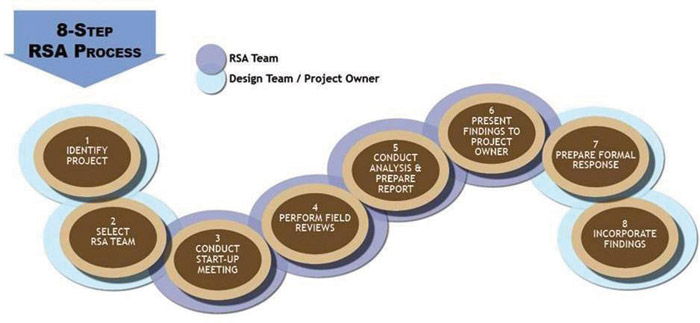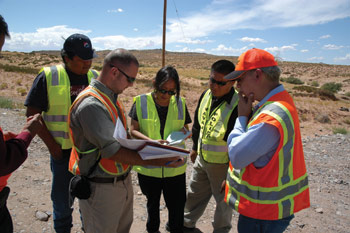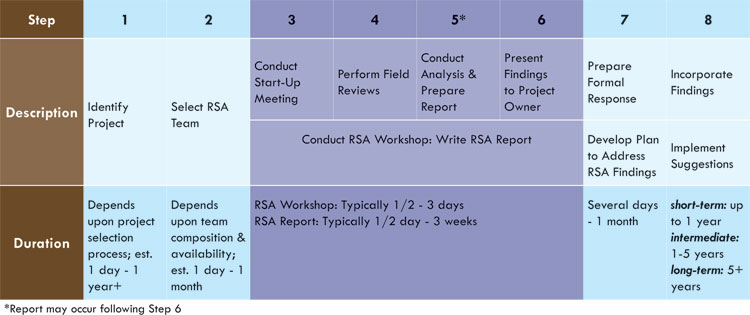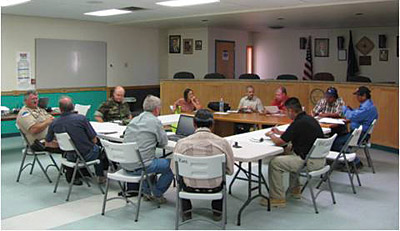This chapter provides critical information needed to conduct an RSA. Special considerations for FLMAs and Tribal transportation agencies in each step of the 8-step RSA process are described to help improve safety on and adjacent to Federal and Tribal lands.
What is an RSA?
A Road Safety Audit/Assessment (RSA) is a formal safety performance examination of a future roadway project or an in-service facility that is conducted by an independent, experienced, multidisciplinary RSA team.
The primary focus of an RSA is safety while working within the context of the facility’s existing mobility, access, surrounding land use, and/or aesthetics. RSAs enhance safety by considering potential safety issues presented to all road users under all conditions (e.g., day/night and dry/wet conditions). By focusing on safety, RSAs ensure that potentially hazardous roadway and roadside elements do not “fall through the cracks.”
RSAs are commonly confused with other review processes, particularly traditional safety reviews. Traditional safety reviews are missing one or more of the key elements of an RSA. Table 1 compares the key elements of an RSA with the elements that are typically part of a traditional safety review or other safety study.
Table 1: What are RSAs?
| RSAs are: |
RSAs are not: |
|---|---|
|
|
What Should be Considered for an RSA?
The RSA process may be employed on any type of facility and during any stage of the project development process, including existing facilities that are open to traffic. RSAs conducted during the pre-construction phase can be particularly effective because there is an opportunity to address a number of safety issues. RSAs conducted in later stages have less ability to address these issues.
In addition to vehicular traffic safety issues, RSAs can also be oriented to specific user groups such as pedestrians and bicyclists. The RSA would still consider all potential users but may have a particular consideration for the needs of a specific group.
Common factors leading to requests for RSAs during the existing road stage include high crash frequencies, high profile crash types or political influence, and significant changes in traffic characteristics (current or expected). A potential factor leading to the request for an RSA in the planning or construction phase includes novel designs for the area, such as the introduction of a roundabout. Another factor may be a major change in the surrounding land use that accompanies the project.
The selected project should be scoped in size so that the RSA can be accomplished in a reasonable amount of time, usually two to three days or one week at most. For a corridor, this is generally a corridor of one to two miles in length or a longer corridor that is concentrated on issues at four or five spots within the corridor. For intersection projects, the scope should be limited to a series of four or five intersections.
How is an RSA Conducted?
The FHWA Road Safety Audit Guidelines document (Publication FHWA-SA-06-06) describes the 8-step process for conducting RSAs. These steps are shown in Figure 1 illustrating the primary responsibilities of the project owner/design team and the RSA team. This section describes how these steps apply to an RSA conducted on or near Federal or Tribal lands.

Figure 1 : RSA Process
 STEP 1: Identify Project or Existing Road for RSA
STEP 1: Identify Project or Existing Road for RSA
Typically, the facility or project owner identifies the location(s) to be reviewed during the RSA. Jurisdictional authority of facilities involving Federal or Tribal lands can be unique. It is common that RSAs conducted at the request of FLMAs or Tribal transportation agencies are on facilities with different ownership, such as a State or local agency. In this case, a facility or project identified by a FLMA or tribe would need to contact the owning agency to request an RSA. For instance, a request may be initiated because of safety concerns about a road running adjacent to or through a Federal or Tribal land.
If, however, the FLMA or Tribal government is the owner, the approach can be decided internally within the agency. Depending on factors such as available staffing and funding, one of the following approaches may be taken:
- Issue a Request for Proposal (RFP) to obtain an experienced RSA team leader;
- Obtain technical assistance from FHWA, State or local Department of Transportation (DOT); or,
- Attend training to conduct your own RSAs.
Once the facility or project is identified, the RSA scope, schedule, team requirements, tasks to be completed, report format and content, and response procedures should be defined.
The appropriate season for the RSA review should also be established. For example, special events, or seasonal conditions are important to consider for the timing of the RSA.
 STEP 2: Select Independent and Multidisciplinary RSA Team
STEP 2: Select Independent and Multidisciplinary RSA Team
Selecting a knowledgeable RSA team is vital to the success of an RSA. The facility or project owner is responsible for selecting the RSA team or the RSA team leader. Regardless of ownership the assistance of other local agencies may be sought due to their familiarity with the area. It is important that the RSA team is independent of the operations of the road or the design of the project being assessed to assure two things: that there is no bias in the assessment and the project is reviewed with “fresh eyes.”
See the Resource Materials section for items to assist with identifying an approach to conduct an RSA:
- Example RFP
- Example application
The RSA team should include (but are not limited to) individuals with the following expertise:
- Road Safety
- Traffic Operations
- Road Design
- Transportation Planning
- Enforcement/Emergency Medical Service (EMS)
- Public Health
- Human Factors
- Maintenance
- Tribal Culture/Natural Preservation
- Community Organizations
- User Groups (pedestrians, bikers, ATV users)
Depending on different needs, the RSA team could include other specialists to ensure that all aspects of safety performance of the given facility can be adequately assessed.
The size of the RSA team may vary. The best practice is to have the smallest team that brings all the necessary knowledge and experience to the process for the specific location(s) being reviewed. As a general rule, the RSA team should be able to travel in one vehicle (except for police and EMS) so the team can review and discuss conditions in the field collectively.
Case Study
An RSA for the Navajo Nation in San Juan County, Utah included team members from the Navajo DOT, Navajo police, Utah DOT (UDOT), Bureau of Indian Affairs (BIA), Indian Health Services (IHS), FHWA, and the County. All members provided useful insights during the RSA process and several team members commented on the benefit of listening to and learning from their teammates who provided a different perspective on the safety issues and potential improvements. In particular, the public health representative contributed valuable information regarding road-user demographics as well as opportunities for educational improvements, such as road safety campaigns.

 STEP 3: Conduct Start-up Meeting to Exchange Information
STEP 3: Conduct Start-up Meeting to Exchange Information
The purpose of the start-up meeting is to ensure the project owner/design team and all RSA team members understand the purpose, schedule, and roles and responsibilities of all participants in the RSA. This meeting helps establish lines of communication between the RSA team leader and the project owner/design team. At the end of the meeting, all parties should have a clear understanding of the scope of the RSA to be undertaken and each of their roles and responsibilities. Specific topics of discussion may include:
- Review the scope and objectives of the RSA.
- Review all relevant data, information, drawings, aerials, photos, etc.
- Discuss design constraints, standards used, findings of previous RSAs/safety studies, local traffic laws, statutes, and customary usage affecting road users.
- Communicate any other matters of importance to the RSA team.
If possible, the owner and/or design team should provide data describing the existing and planned conditions (if applicable) as well as the existing safety performance (e.g., crash records/data, traffic volumes, etc.). Ideally data will be provided prior to the start-up meeting for review/analysis by the RSA team. This will enable the team to ask detailed questions at the start-up meeting. Naturally the desired data may not be readily available; however, any information that can be provided to the RSA team is beneficial to the understanding of the location(s) to be reviewed and the potential safety issues.
See the Resource Materials section for items to assist with the start-up meeting:
- Example agenda
- Typical data requested
- Example collision diagram & worksheet
 STEP 4: Perform Field Reviews under Various Conditions
STEP 4: Perform Field Reviews under Various Conditions
The RSA team should review the entire site (as well as plans if conducting an RSA of a design), documenting potential safety issues and project constraints (e.g. available right-of-way, impact on adjacent land). Issues identified in the review of project data (e.g., safety concerns related to crash clusters) should be verified in the field. Key elements to observe include:
- Site characteristics (road geometry, sight distances, clear zones, drainage, surface condition, signing, lighting, and barriers).
- Traffic characteristics (traffic volume, movements, typical speeds, and traffic mix).
- Surrounding land uses (including traffic, pedestrian, and bicycle generators).
- Human factors issues (such as road user “expectancy,” reactions, and other behaviors).
The FHWA Road Safety Audit Guidelines and Pedestrian Road Safety Audit Guidelines and Prompt Lists provide prompts to help the RSA team identify potential safety issues and ensure that roadway elements are not overlooked.
A thorough site visit will include field reviews under various conditions. At a minimum, the RSA team should review the site during the following conditions:
- Day and night to experience conditions from the perspective of all roadway users during different lighting scenarios.
- Peak and non-peak to experience the influence of traffic conditions on safety, mobility, and access.
See the Resource Materials section for items to assist with the field review:
- Example field notes sheet
- List of materials needed for field review
 STEP 5: Conduct RSA Analysis and Prepare Report Findings
STEP 5: Conduct RSA Analysis and Prepare Report Findings
The RSA team conducts an analysis to identify safety issues based on data from the field visit and preliminary documents. The safety issues may be prioritized by the RSA team based on the perceived risk. For each identified safety issue, the RSA team generates a list of possible measures to mitigate the crash potential and/or severity of a potential crash. Chapter 2 provides more detailed information on this step of the process.
The RSA team then prepares a summary of the safety issues and related suggestions for improvement. Prior to preparing a report, the team may meet with the owner and/or design team to discuss preliminary findings (Step 6).
The RSA report should include a brief description of the project, a listing of the RSA team members and their qualifications, a listing of the data and information used in conducting the RSA, and a summary of findings and proposed safety measures. It should include pictures and diagrams that may be useful to further illustrate issues and countermeasures.
See the Resource Materials section for additional guidance on report content and format:
- Example report outline
- Example presentation of issues & suggestions
 STEP 6: Present RSA Findings to Owner/Design Team
STEP 6: Present RSA Findings to Owner/Design Team
The results of the RSA are presented to the owner/design team. The purpose of this meeting is to establish a basis for writing the RSA report and to ensure that the report will adequately address issues that are within the scope of the RSA process. This is another opportunity for discussion and clarification. The project owner/design team may ask questions to seek clarification on the RSA findings or suggest additional/alternative mitigation measures.
 STEP 7: Prepare Formal Response
STEP 7: Prepare Formal Response
Once the owner and/or design team have reviewed the RSA report, they should prepare a written response to its findings. The response should outline what actions the owner and/or design team will take with respect to each safety concern listed in the RSA report. A letter, signed by the project owner, is a valid method of responding to the RSA report. The RSA findings may be presented in a public meeting or the report could be made available to the public to help garner support for the findings and the overall RSA process. This can be particularly beneficial on projects with a high degree of public involvement, such as pedestrian facilities.
 STEP 8: Incorporate Findings into the Project when Appropriate
STEP 8: Incorporate Findings into the Project when Appropriate
After the response to the RSA report is prepared, the project owner and/or design team should work to implement the agreed-upon safety measures or create an implementation plan. RSA findings can be incorporated into an agency’s planning process, as discussed in Chapter 4. An important consideration is to evaluate the RSA program and share lessons learned. An RSA “after action review” can be scheduled for the RSA team to evaluate the effectiveness of the suggested measures implemented and to evaluate if other measures are needed.
What are the Time Requirements and Costs Associated with an RSA?
The time and cost to complete an RSA vary based upon conditions such as project extents, level of detail, logistics, and team size. Figure 2 presents a generalized timeline of the RSA process. Please note that the writing of the report does not necessarily have to occur in Step 5; it can be completed following the presentation of preliminary findings in Step 6.

Figure 2: RSA Time Requirements by Step
In total, the entire RSA process (Steps 1 through 8) could range from a month to a couple years. The cost to conduct an RSA depends largely upon the approach (discussed in Step 1) and the level of effort required by the RSA team.
Who Should I Partner With to Set-Up an RSA?
Several Federal, Tribal, State, and local agencies have used RSAs as a tool for improving safety. Initially, it is important to identify a local champion, either internally or externally, to support the RSA and its outcome (see Chapter 3 for more details). If the RSA is on or adjacent to Federal or Tribal lands, the local champion should be able to communicate effectively with all parties involved. It is particularly important to communicate the need for and desired outcome of an RSA. The next challenge is to assemble an independent RSA team. Since independence is a requirement of an RSA, the agencies may contact the State and/or local DOT, Local and/or Tribal Technical Assistance Program (LTAP/TTAP) center, FHWA Division Office, FHWA’s RSA Peer-to-Peer Program, FHWA’s Federal Lands Division Office, or FHWA’s Offices of Safety and Federal Lands Highway for assistance in finding team members. Federal and Tribal transportation agencies may also find it helpful to contact staff from other nearby Federal agencies or Tribes with whom they may establish a reciprocal relationship.

RSAs conducted on or near Federal or Tribal lands may necessitate involvement from multiple agencies.
